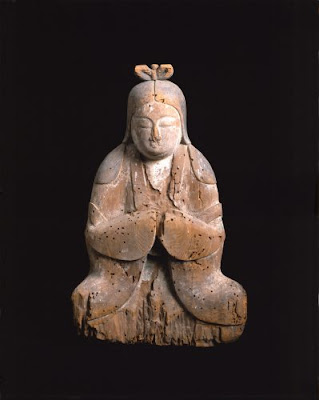
There's a nice piece in the Globe & Mail by Sarah Milroy about Sugimoto's exhibition at Daniel Libeskind's angular brand new extension to the Royal Ontario Museum.


"The leading Japanese artist Hiroshi Sugimoto is a man of extreme paradoxes, and his touring exhibition History of History, the inaugural show in the just-opened Institute for Contemporary Culture at Toronto's Royal Ontario Museum, brings that complexity to life.Comprised of both the artist's own work and objects from his private collection, the show allows us to take the full measure of the man.
On the one hand, his serene photographs of the open ocean – wide, uninflected expanses divided only by the horizon line – are the ultimate symbols of eternity, mindfulness and enlightenment. A man of philosophical bent, Sugimoto calls them his attempt to recapture the experience of the first human who contemplated the ocean, in the dawning days of our species, and as depictions of the two most elemental necessities for life: air and water. Other works in this show, such as his palm-sized 13th-century Buddhist “flaming jewel” reliquary fitted out with a tiny oceanscape, seem like contemplative objects that direct us to the eternal.
Yet Sugimoto, 59, is also the ultimate international art star, with a home in New York, a custom-designed apartment aerie in Tokyo, a list of exhibition engagements as long as your arm (Venice, San Francisco, Dusseldorf, Tokyo) and a growing collection of Japanese antiquities, scroll paintings and natural-history specimens (such as fossils), many of which are included in this exhibition. (In the eighties, he augmented his artist's income by dealing in Japanese antiquities – artists Dan Flavin and Donald Judd were among his clients – but he shut his New York gallery, Mingei, in 1990.) So which one is he: The Zen monk with a camera or the shrewd businessman with a strategic eye for profit and advancement? Will the real Sugimoto please stand up...
A conversation about his current collecting activities reveals flashes of avarice and rivalry. He talks with me about his recent passion for medieval miniatures, Greco-Roman antiquities and the set of three used juice boxes from the Apollo 11 moon launch that he acquired at a recent scientific auction. But his big thrill of late is his pursuit of the rare, early negatives made by pioneering British photographer William Henry Fox Talbot in the 1830s. Sugimoto now owns 15 of these, which record plants and various oblique views of Talbot's castle near London. They have never been printed, and he plans to make pictures from them. “I spent one whole year's income on these negatives,” he says to me. “But since I will be using it to make my art, I can write it off. I am creating my art by buying another person's art. I call this art anarchism,” he says with a triumphant laugh, “because I don't pay tax!”
Even more delightful to him is his success at stealing the thunder of his slower-moving institutional competitors. “The Getty Museum has 20,” he says, “and the Metropolitan has 10, so I am number two.”
Not bad for the new kid on the block.
Anyone expecting a courtly display of deference from Sugimoto during his public “conversation” with ROM architect Daniel Libeskind on May 31 was also in for a shock. The artist came out swinging, winning the crowd instantly with his witty derision of star architects and their indifference to the needs of the user (in the case of museum design, the artist as well as the public), pummelling Libeskind with his gaily administered humiliations, including the suggestion that the architect would have been “better off to remain an unbuilt architect,” making drawings, not buildings.
Sugimoto then went on to explain the thinking behind the magnificent curving display wall he has designed for the Toronto show. The ICC is a dramatic, angular gallery with sloping ceilings that is strikingly bereft of walls for hanging art on. “I am trying to fit into his difficult space,” he said to me, “so I have to be difficult too. He makes straight lines so I make curved lines. It is my revenge.” Make no mistake: This is one intensely competitive human being...." more









No comments:
Post a Comment